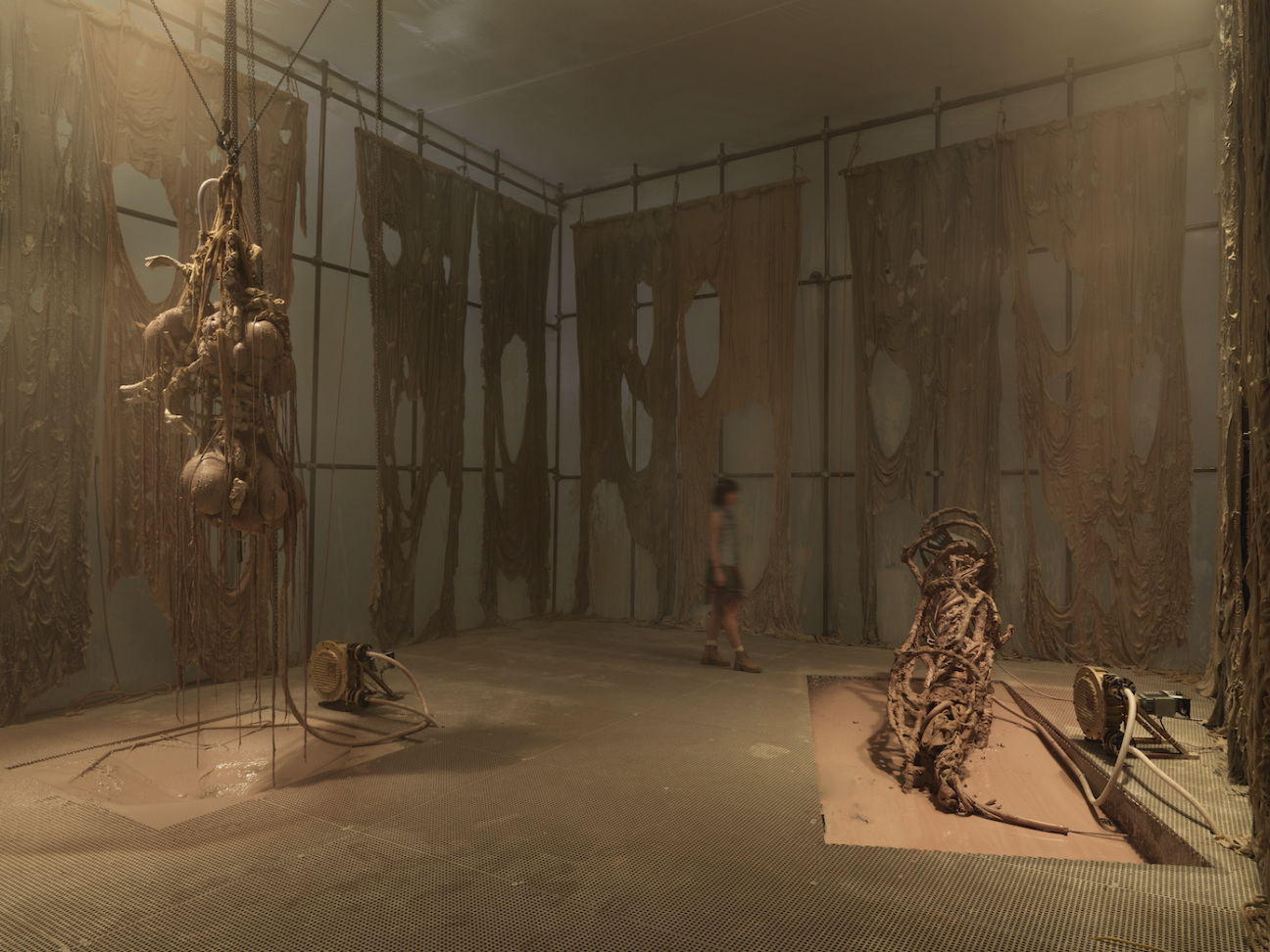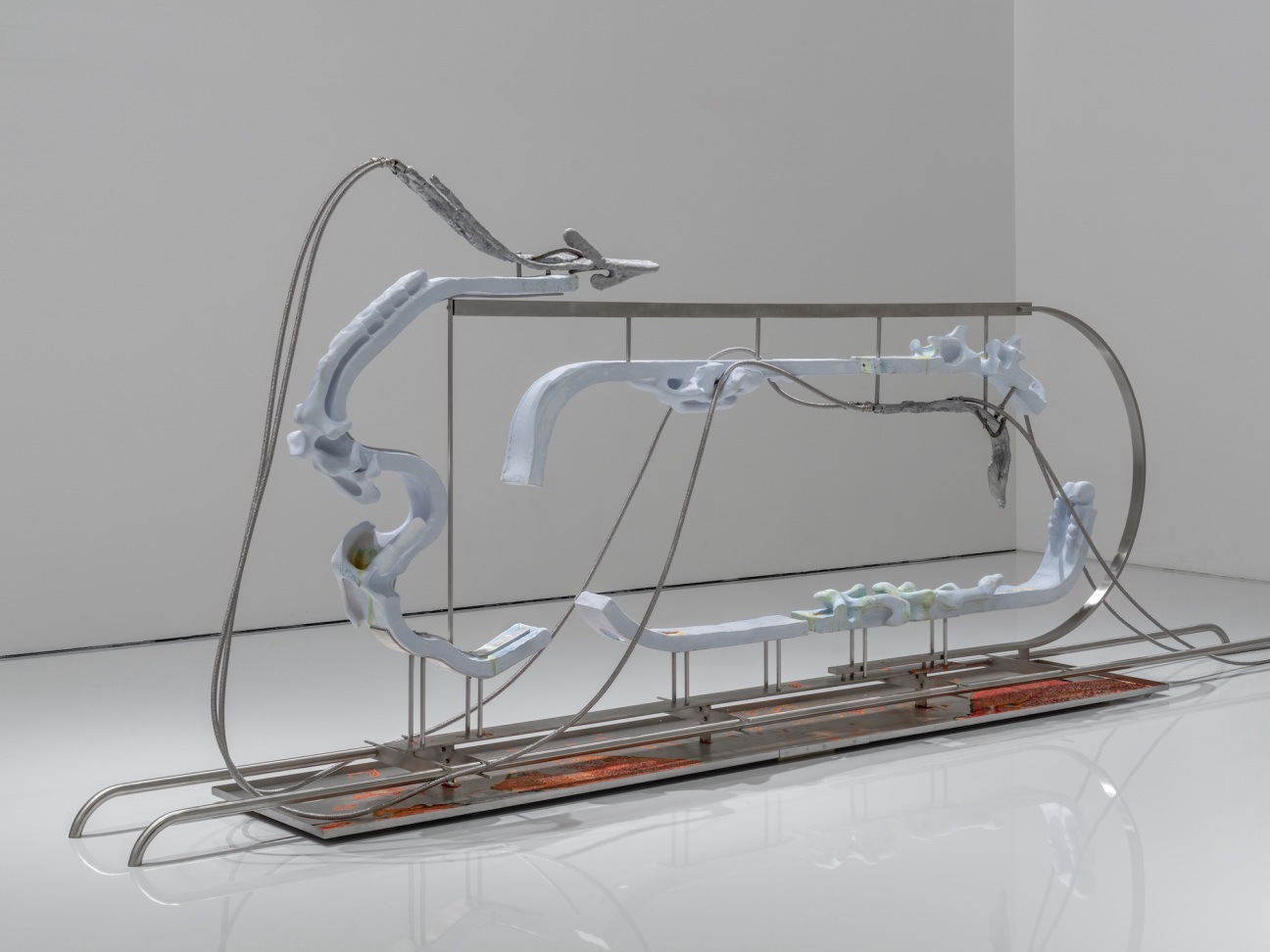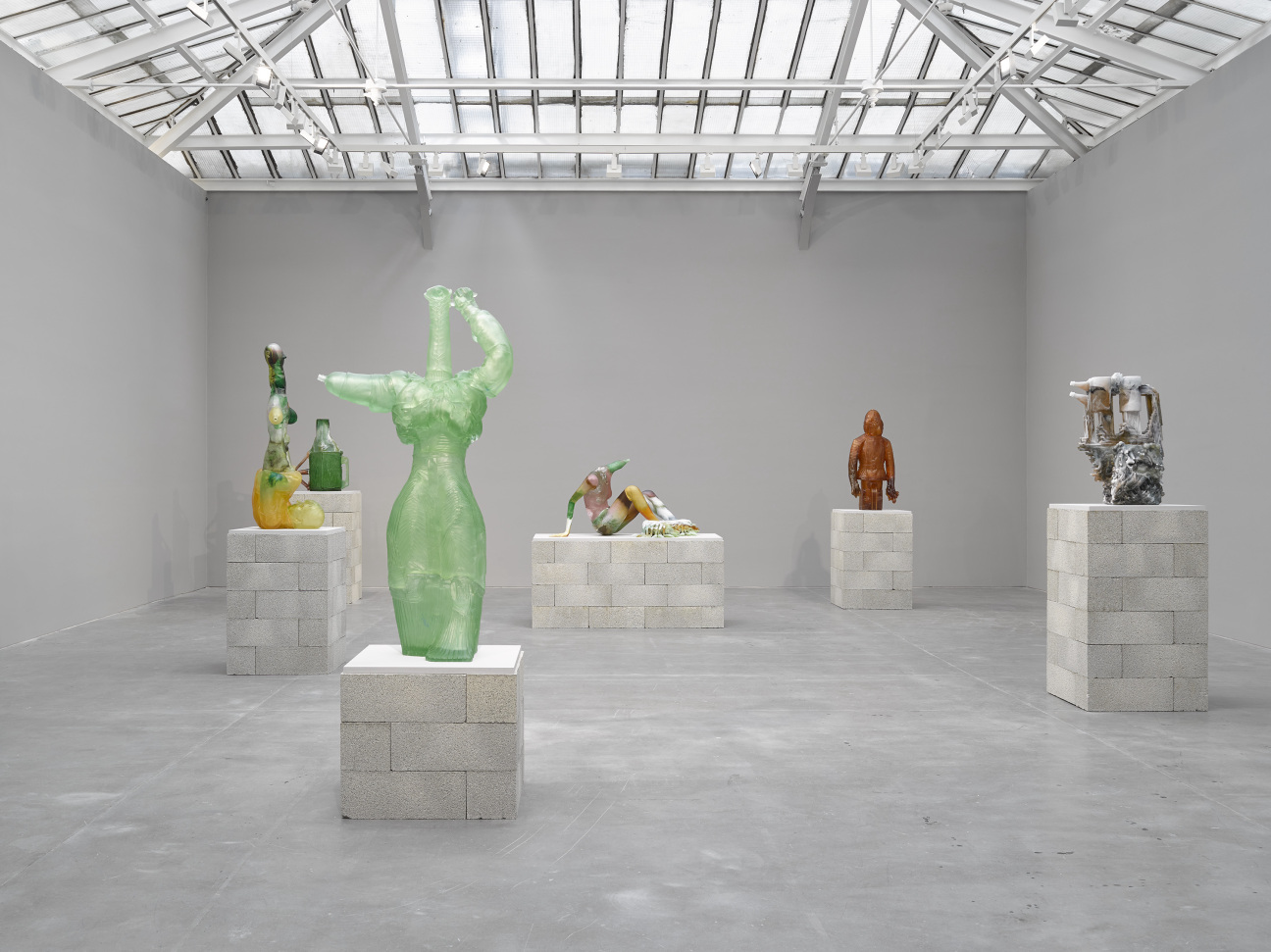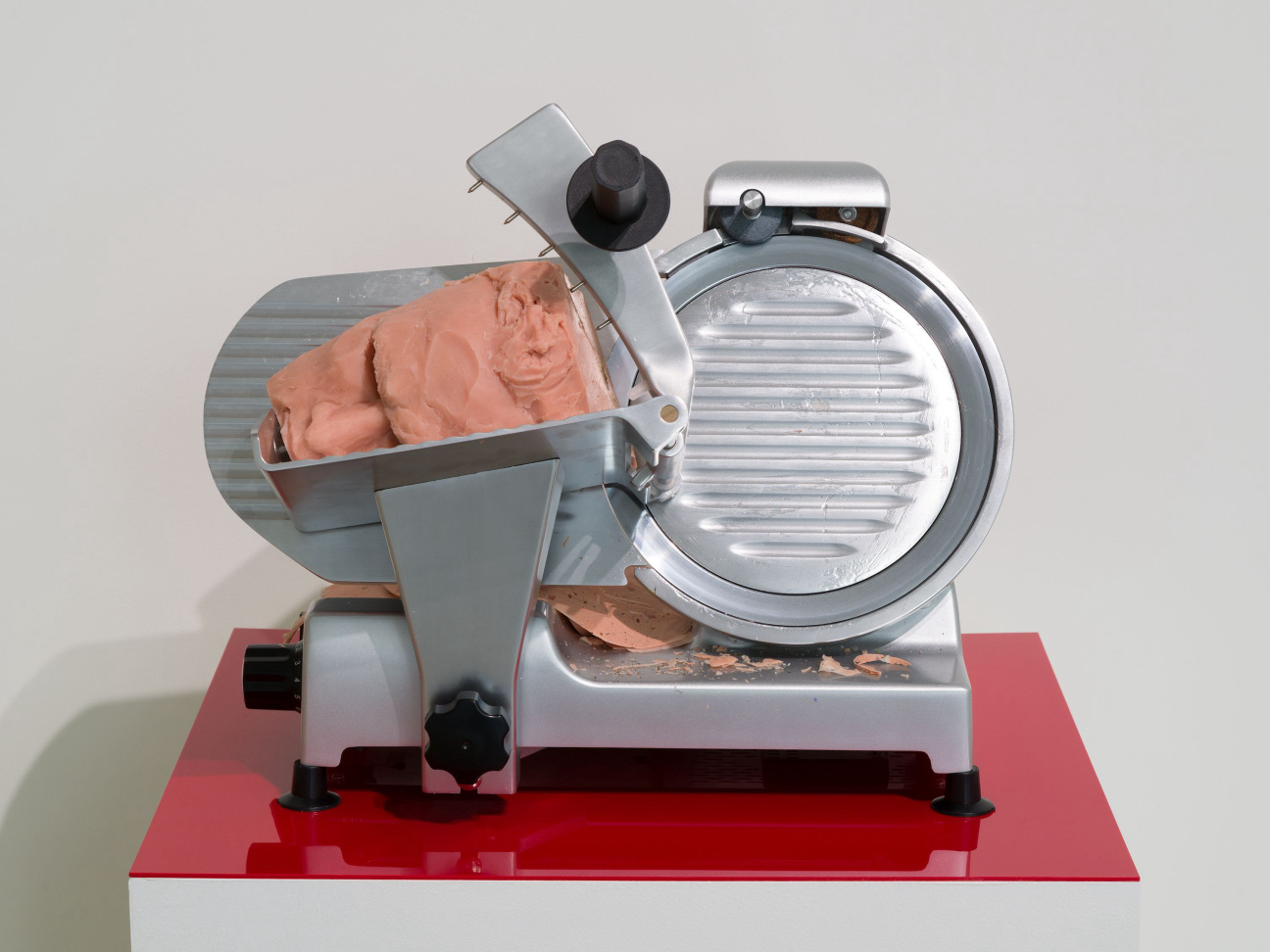
Imagine a meat locker or a mad scientist’s lair: that’s what the New Museum’s fourth floor looks like today. Plastic-lined scaffolding forms a dank, fetid room within a room that appears to sweat. Inside, a torqued rod wrapped in ropy limbs—entrails, perhaps, or tentacles—twists slowly and menacingly, tangling in on itself until it looks like it’s about to break. Then, all of a sudden, the appendages snap free and spray clay on anyone there to bear witness. The sense of release is orgasmic—and gross.
This is the work of Mire Lee, a young South Korean sculptor whose practice marries the brute machinery of the industrial world with the goo and guts of the biological one. Visceral in every sense of the word, her sculptures leak, wriggle, and stink. They are hard to look at, but harder to look away from. And they’ve struck a chord with top curators: Last year alone, Lee’s work was included in the Busan Biennale, the Venice Biennale, and the Carnegie International. “When you enter Mire’s space, it's impossible not to feel something,” says New Museum curator Madeline Weisburg.

Lee’s vision is all her own, but the themes of her work belong to a larger trend among young sculptors, mostly women, who are mapping the amorphous anxieties of modern life onto human anatomies. Artists Isabelle Andriessen, Agata Ingarden, Hannah Levy, and Dominique White have turned to the body as metaphor, but also something more: a conduit to make us feel ideas rather than merely understand them. Their interest is more sensorial than intellectual.
These artists’ influences range from the psychologically charged art of Louise Bourgeois and the punny, somatic surrealism of Alina Szapocznikow to creature features, Internet porn, Manga, cybernetics, and science history. Their carnal, uncanny work hits hard in a post-pandemic world, where we are all suddenly hyper-aware of the fragility of our physiques and destabilized by the disembodied threat of AI.

Body horror's most well-known poster child might be director David Cronenberg, whose films like Videodrome, 1983; The Fly, 1986; and Existenz, 1999, envision not-so-distant futures where advanced technologies encroach on—and often subsume—the people they were designed to benefit. The science that enabled these innovations is always contested territory; governments, corporations, political parties, and medical establishments vie for control. But whereas Cronenberg’s films reflect the paranoia of a generation raised by TV and taught to fear sex, the work of Lee and others has a murkier millennial cast. They don’t need to imagine a world where the government regulates female bodies, or where the lines between man and machine are blurred. That’s all a fait accompli.
Now, these artists are left to imagine what happens next. “I think reality has just completely overtaken our wildest imagination about how bad things could get,” says the Romanian artist Andra Ursuţa, whose recent series of hollow glass creatures cast from Frankensteined-together trash and sci-fi movie props are unnerving enough to make author Clive Barker blush. One figure has a bottle for an arm and feet forged from the head of the Predator; another features the artist’s own face—wearing a mask from Alien, no less—atop what looks like the base of a blender.

Then there is Serbian artist Ivana Bašić, who creates humanoid alabaster figures that are alternately propped up and pierced by steel. Some look like shriveled organs on skewers, others like incubating Xenomorphs waiting to hatch. They embody all the weight of a world increasingly mediated by screens and machines: the ache of a teeming email inbox, the phantom itch of a phone-less palm, the almost incapacitating fatigue that follows an idle day of work in front of a laptop.
Most are arrested in states of transformation. In the artist’s twin 2017 artworks I will lull and rock my ailing light in my marble arms, hunched figures appear to be simultaneously mutating and giving birth as blown-glass bulbs resembling amniotic sacs emerge from cavities in their necks. But where there is change, there is also potential. “I'm trying to think about what it means to return to formlessness and be liberated from the constraints of this material world,” Bašić says. “Can it be that the disappearance and disintegration of the body is not just a point of loss, but a point of hope?”

The American artist King Cobra (Doreen Lynette Garner) takes a less sanguine approach by looking to the past, not the future, as a source of horror. Her May exhibition at JTT, called “White Meat,” featured a series of "Cracker" sculptures, based on the first nine U.S. presidents, and a related pair of "White Assholes," made from rubber. Most were covered in sores and boils: a reference to the diseases European colonizers introduced to Native Americans upon settling in America. “With that show, I started to take on this identity of the joker,” says Cobra. “It's not necessarily about doing heinous acts but about pushing a mirror up to the monster itself.”

Also on view was the silicone head of J. Marion Sims—a 19th-century physician who conducted experimental transvaginal surgeries on enslaved African Americans in a backyard lab—being forced through a deli slicer. Sims, a frequent subject of Cobra’s, could be a Cronenberg character in his wanton disregard for human life in the pursuit of science.
Cobra’s creations can draw strong responses. Of the artworks that made up “White Meat,” one reviewer wrote: “These objects are so revolting that leaving the space was the only way to avoid throwing up on the gallery’s concrete floor.” The artist, for her part, has no time for such handwringing, and entirely dismisses the idea that her work could ever go “too far” in its terror. “When people talk about shock and horror, it's actually just a small, light reference to a real history,” she says. “The grotesqueness is no comparison to the actual acts that have happened.”










 in your life?
in your life?

